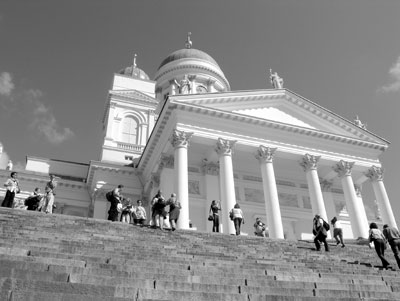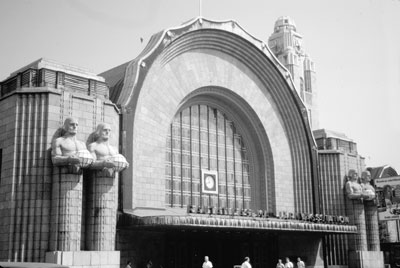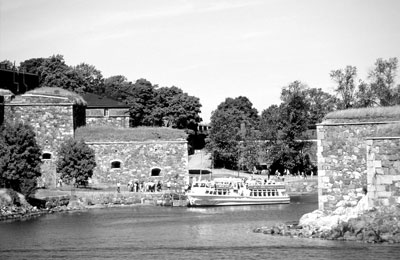By train to Russia
by Jay Brunhouse
Kicking off your Eastern adventure by train to Mother Russia, you can climb the steps to a through carriage from Berlin or Prague or a direct train from Helsinki. Choose the train from Helsinki for convenience and comfort.
From Prague your carriage travels through Slovakia and Ukraine before reaching Moscow, and the Ukraine authorities require a separate visa that is extremely painful to get at the border crossing. Further, there is a time-consuming change from European gauge to wide gauge when your train enters Ukraine. The trip takes 31 hours.
From Berlin, you pass through Poland and Belarus, which require no additional visas of Americans, but again you suffer a change of gauge. The trip takes 29 hours.
To Russia from Finland, on the other hand, there is no change of gauge, the trains are specially designed for the trip, St. Petersburg is relatively close to Helsinki, and you receive a slight price reduction using a Finnrail Pass, a Scanrail Pass or a Eurail product valid in Finland. The trip to Moscow takes 12 hours, and St. Petersburg is only six hours distant.
Jumping off
Three trains depart daily for Russia from Helsinki. All stop at Vainikkala, the border crossing where you advance your watch for the time change. Border guards check your papers aboard the running train, and you can also exchange money if you please. Should you have anything to declare, advise the train crew before arriving at the border.
Sibelius is the Finnish morning train to St. Petersburg using dual-voltage Pendolinos. Tip — always request the Sibelius. The first-class carriage contains six closed compartments, each seating six, and a first-class salon with 11 seats.
Second-class passengers sit airline style two-opposite-two in the wide trains. There is a smoking compartment and seats for passengers with allergies.
The Sibelius’ restaurant carriage has a dining room with 38 seats plus a coffee shop with five seats and standing room for 10. You may pay your bills aboard the Sibelius with euros, Swedish crowns, British pounds or U.S. dollars, and you may use your credit card.
Repin is the Russian afternoon train to St. Petersburg, and Tolstoi is the Russian night train to Moscow. All Russian carriages have their own no-nonsense coach attendant. First-class Repin passengers sit two passengers per compartment. They each receive a soft drink with sweet snack served at their seat. Second-class passengers on the Repin sit six per compartment.
The Tolstoi night train is air-conditioned, with a closed WC system and electronic data displays. The berths, which are longer than those on Western trains, are a plus. Second--class ticket holders sleep in 4-person compartments. First-class passengers sleep in compartments for two persons. In addition, you can book sleeping compartments in a “Business Coach” that has a lounge, a bar and only five 2-person sleeping compartments, each with a shower.
City of culture
Helsinki, population 560,500 (50,000 are university students), one of the nine European Cities of Culture in 2000, is the economic powerhouse and administrative center of Finland. It has become increasingly cosmopolitan since Finland joined the European Union in 1995, and the city is now the center of the country’s optimism about its future. Economists say that, unlike the doldrums of the Old Europe EC countries to the south, Finland is booming both economically and psychologically.
One of the new features of Helsinki’s cityscape is the Design District that in 2005 became a shopping destination. In the designated district, you may ogle the windows of design shops such as Artel (Alvar Aalto furniture) and iittala (glass, kitchenware and tableware), jewelry shops, art galleries, studios, interior-decorating shops and clothing boutiques. Design Forum Finland, Design Museum and the Museum of Finnish Architecture form the core of the district, which showcases things cool and contemporary and reflects the Finnish affinity for nature.
In addition, visitors flock to see Helsinki’s traditional must-see sightseeing showpieces such as Senate Square, the ensemble of neoclassical buildings representing the soul of Finland that is dominated by the mighty neoclassical Lutheran Cathedral.
The marvelous Temppeliaukio Church, which everyone calls the Rock Church, is constructed into solid rock with unfinished granite walls and a rolled copper roof. Within, you feel as if you are inside an artwork.
Suomenlinna sea fortress outside Helsinki is one of the largest in the world and was inscribed in 1991 in the list of UNESCO World Heritage Sites (http://whc.unesco.org/en/list/583). The ferry to the island from Helsinki’s Market Square takes 15 minutes.
You can buy a Helsinki Card for one, two or three days for Ä25, Ä35 or Ä45, respectively. It entitles you to free entrance to all of the city’s major sights and nearly 50 museums, free travel on public transportation systems as well as the ferry to Suomenlinna, and more.
Train stations
To describe Helsinki’s train station, I quote Allen Noren’s romantic vision from his riveting travel novel, “Storm” (2000, Travelers’ Tales Guides. ISBN 1885211457).
“We stopped and studied the Helsinki main train station several times, a building I had wanted to see since I first discovered a picture of it in an encyclopedia as a boy. The exterior façade was what had struck me. It was a handsome art nouveau building of buff--colored stone that was made extraordinary by the pair of massive sentinels guarding the entrance. They looked like the strong citizens depicted in old Soviet propaganda posters, people who became monolithic by the clarity of their dedication. Each sentinel held a large glass and copper globe that illuminated the front of the building at night. The light hardened their features in a way that made them ominous, like ancient totems that kept spirits at bay. It was as if the station were something holy, a temple, and that all who entered were blessed.”
St. Petersburg’s 2003 Ladoga Station is the city’s most modern. It welcomes hard--currency visitors from Helsinki and, anticipating a high-speed line, provides through service for trains to Moscow. Each year 150,000 Finns visit Russia. You won’t have trouble paying with euros. The station is beautiful, post modernist and airy with an almost gothic interior. It is the second-largest station, by space, in Europe.
Moscow’s Leningrad Station has remarkable arching eaves and an almost whimsical architecture of grand design and magnificent presence. Its interior is Moscow’s best kept. It is accessible, with clean lines, counters selling magazines, etc., and windows for ticketing in the outer hall.
A striking alabaster bust of Lenin dominates the center. The spaces leading to the platforms, which are outside in back of the station, are filled with a wonderful mingling of life. Kiosks and glassed stalls stand in irregular, makeshift rows, their occupants selling anything and everything at very low ruble prices. Passersby crowd to see what is for sale and at what price.
I thank the Finnish Tourist Board (212/885-9700 or www.visitfinland.com) for arranging my visit and stay at the historic, 5-star deluxe Hotel Kamp, Helsinki’s leading hotel (www.luxurycollection.com/kamp).



